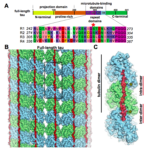Markita Landry, a faculty affiliate of the Molecular Biophysics and Integrated Bioimaging (MBIB) Division, has received a prestigious two-year Department Of Defense Advanced Research Projects Agency (DARPA) Young Faculty Award for her work developing optical probes for neuromodulators such as dopamine. An assistant professor of chemical and biomolecular engineering at UC Berkeley, Landry conducts research at the intersection of single-molecule biophysics and nanomaterial-polymer science to develop new tools to probe and characterize complex biological systems. The DARPA project will focus on using synthetic near-infrared optical nanosensors—a new technology developed in the Landry lab—to develop a brain-computer interface driven by neurochemistry. Currently such technologies rely on electrical signals for signal acquisition, processing, and machine learning algorithms. Read a Berkeley Neuroscience news article to learn about how the award will allow her to investigate visualizing the probes in awake and behaving animals.
Jennifer Doudna Shares 2018 Kavli Prize in Nanoscience for CRISPR-Cas9
The Kavli Prize in Nanoscience, given every other year by the Norwegian Academy of Science and Letters and the Kavli Foundation, was awarded this year to Jennifer Doudna, a faculty biochemist in the Molecular Biophysics and Integrated Bioimaging (MBIB) Division, and two colleagues who developed the powerful nanoscale tool CRISPR-Cas9 to edit DNA. The $1 million award, announced May 31, will be shared by Doudna, an HHMI investigator and professor of molecular and cell biology and of chemistry at UC Berkeley, Emmanuelle Charpentier of the Max Planck Society, and Virginijus Šikšnys of the Institute of Applied Enzymology in Vilnius, Lithuania. The 2018 Kavli Prizes will be awarded on September 4 in Oslo, Norway. “This prize recognizes the profound value of curiosity-driven research, and represents the contributions of our lab members. It’s an honor to share The Kavli Prize with my colleagues,” Doudna said. Read the UC Berkeley news release.
Tau-tally Microtubular: A Structural Model of Tau-Microtubule Interaction
Researchers at Berkeley Lab and UC Berkeley have combined cutting-edge cryo-electron microscopy (cryo-EM) with computational molecular modeling to produce a near atomic-resolution model of the interaction between microtubules—crucial components of eukaryotic cell ultrastructure—and microtubule-associated proteins called tau. The model provides insight into how tau stabilizes microtubules, and what makes it dissociate to form tau aggregates, or “tangles,” in some neurological diseases—including Alzheimer’s disease—generally referred to as tauopathies.
Banfield Elected to the Royal Society
Jillian Banfield, faculty scientist in the Earth and Environmental Sciences Area with a secondary appointment in the Environmental Genomics and Systems Biology Division, has been elected as a Fellow to the Royal Society. She is among fifty scientists who were selected for this honor in recognition of their exceptional contributions to science. Banfield, who is also a professor at UC Berkeley, studies the structure, functioning and diversity of microbial communities in natural environments and the human microbiome. Read more in the Royal Society press release.
Biosciences Researchers Honored by the National Academy of Sciences
Three scientists affiliated with the Biosciences Area have been recognized by the National Academy of Sciences (NAS), one as the recipient of an NAS award and two as newly elected members. On Sunday, the NAS formally presented its 2018 NAS Award in Chemical Sciences to Jennifer Doudna, a faculty biochemist in the Molecular Biophysics and Integrated Bioimaging (MBIB) Division. Judith Campisi, a biochemist affiliated with Biological Systems and Engineering Division, Ehud “Udi” Isacoff, an MBIB faculty biologist, are among the group of 84 new members elected to the NAS.
- « Previous Page
- 1
- …
- 5
- 6
- 7
- 8
- 9
- …
- 17
- Next Page »
Was this page useful?








